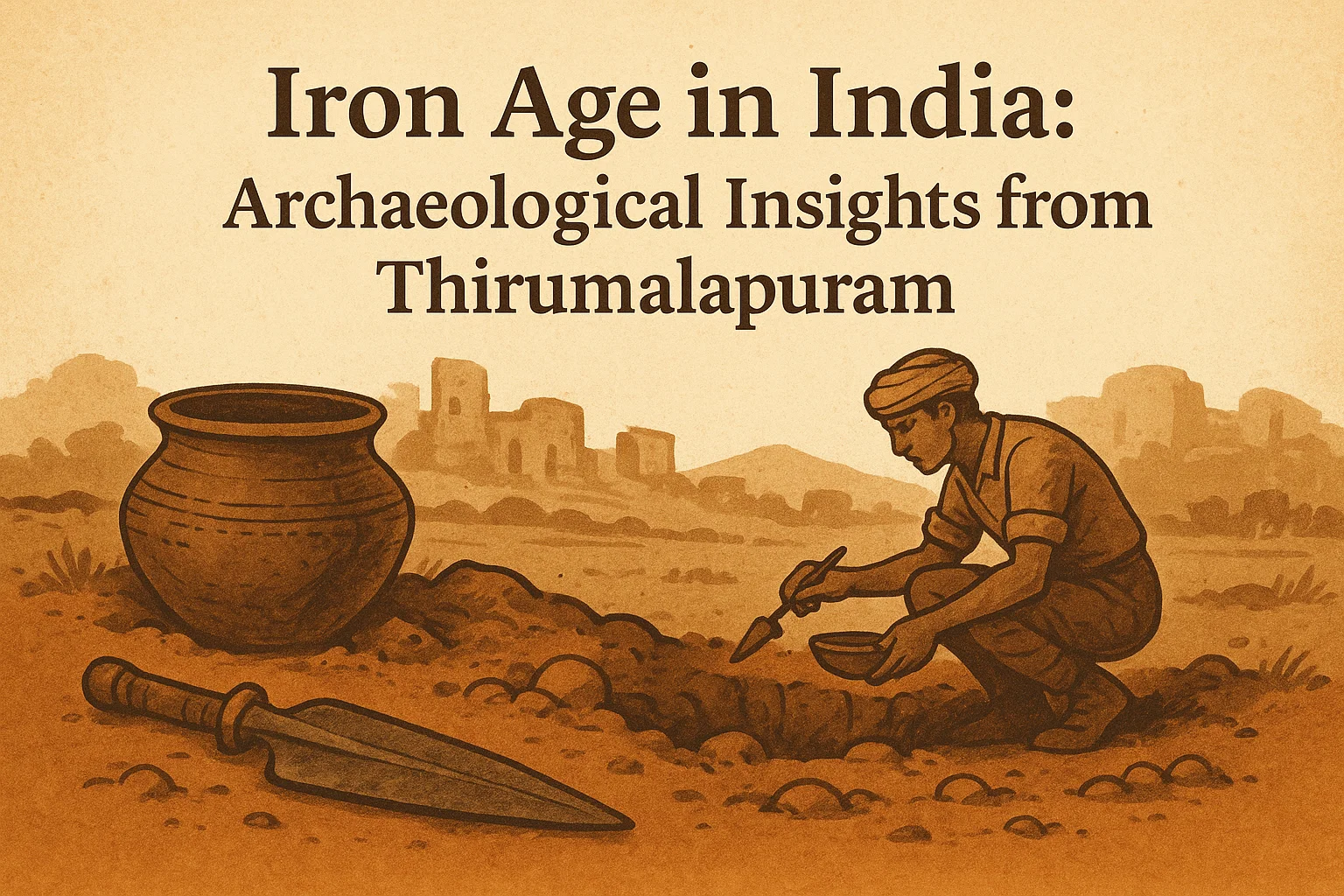Iron Age in India: Archaeological Insights from Thirumalapuram
Explore the Iron Age in India through the Thirumalapuram excavation in Tamil Nadu. Discover insights into ancient burial practices, pottery, iron technology, and the cultural evolution leading to early historic Tamil kingdoms.
Context
A recent archaeological excavation by the Tamil Nadu State Department of Archaeology (TNSDA) at Thirumalapuram in Tenkasi district has unveiled a major Iron Age settlement and burial site. This discovery provides valuable insights into ancient life, technology, and socio-cultural practices in southern India.
Understanding the Iron Age
The Iron Age (c. 1300 BCE–700 AD) marks one of the most transformative periods in human civilisation. It succeeded the Stone and Bronze Ages and witnessed the widespread use of iron to make tools and weapons. This technological breakthrough reshaped agriculture, warfare, and society, enabling greater productivity, population growth, and complex governance systems across Europe, Asia, and Africa.
The Iron Age in India
In India, the Iron Age saw the emergence of diverse regional cultures marked by distinctive pottery, metallurgy, and settlement patterns. Archaeological evidence links the period to the Painted Grey Ware (PGW) culture in northern India and megalithic traditions in the south. Key cultural markers such as Black Slipped Ware, Black-and-Red Ware (BRW), and Red Ware are found across multiple regions.
| Region | Prominent Sites |
|---|---|
| North India | Hastinapur, Mathura, Atranjikhera, Kausambi (Uttar Pradesh) |
| Central India | Nagda and Eran (Malwa), Ahar (Rajasthan) |
| South India | Naikund, Khairwada, Pachkhed (Maharashtra); Adichanallur, Sivagalai, Thirumalapuram, Paiyampalli (Tamil Nadu); Porkalam, Kudakkallu Parambu (Kerala) |
Key Characteristics of the Iron Age
1. Technological Advancement:
Iron tools revolutionised agriculture and industry. Farmers could now clear dense forests, cultivate more land, and produce surplus crops, paving the way for social complexity and trade expansion.
2. Megalithic Burials:
A hallmark of the South Indian Iron Age, megalithic burials were large stone monuments constructed to honour the dead. These included dolmens, cairn circles, and urn burials, often containing grave goods such as weapons, beads, and pottery. They indicate beliefs in the afterlife and social stratification within the community.
3. Distinct Cultural Artefacts:
Pottery styles such as Black-and-Red Ware with white-painted geometric designs reflect a shared artistic tradition. Other artefacts include terracotta figurines, iron implements, and semi-precious stone beads, showing the sophistication of Iron Age craftsmanship.
4. Link to Early Historic Periods:
The Iron Age laid the foundation for the early historic Tamil kingdoms of the Sangam age. The emergence of urban centres, trade networks, and literary culture in southern India can be traced back to the technological and social developments of this period.
New Discoveries at Thirumalapuram
The Thirumalapuram site, dating as far back as the mid-third millennium BCE, has yielded several remarkable findings:
1. Vast Burial Ground:
The site spans nearly 35 acres, suggesting a large and well-organised community. Its scale points to social complexity and possibly a centralised system of governance or ritual management.
2. Unique Stone Slab Chamber:
The most notable find is a rectangular stone slab chamber containing urn burials. Built using 35 slabs and filled with cobblestones, this structured cist burial demonstrates advanced architectural and engineering knowledge, rare for this period in Tamil Nadu.
3. Diverse Pottery Collection:
Findings include white-painted Black-and-Red Ware, Red Ware, Red-slipped Ware, Black-polished Ware, and Coarse Red Ware. The uniformity in designs across multiple sites such as Adichanallur and Korkai highlights extensive cultural interaction.
4. Symbolic Markings on Urns:
Some burial urns bear symbolic engravings. Though still under analysis, these symbols likely denote clan identity, social status, or religious significance.
5. Strategic Location:
Situated between two seasonal streams from the Western Ghats, Thirumalapuram’s geography reflects the ancient community’s dependence on water resources and trade routes. The location also suggests participation in inter-regional exchange networks.
Significance of the Findings
The Thirumalapuram excavation reinforces that the Iron Age in India was not a uniform phase but a mosaic of regional cultures, each contributing uniquely to the subcontinent’s historical evolution. The discovery bridges the gap between prehistory and early history, revealing a civilisation rich in technological skill, social organisation, and spiritual belief.
Subscribe to our Youtube Channel for more Valuable Content – TheStudyias
Download the App to Subscribe to our Courses – Thestudyias
The Source’s Authority and Ownership of the Article is Claimed By THE STUDY IAS BY MANIKANT SINGH

